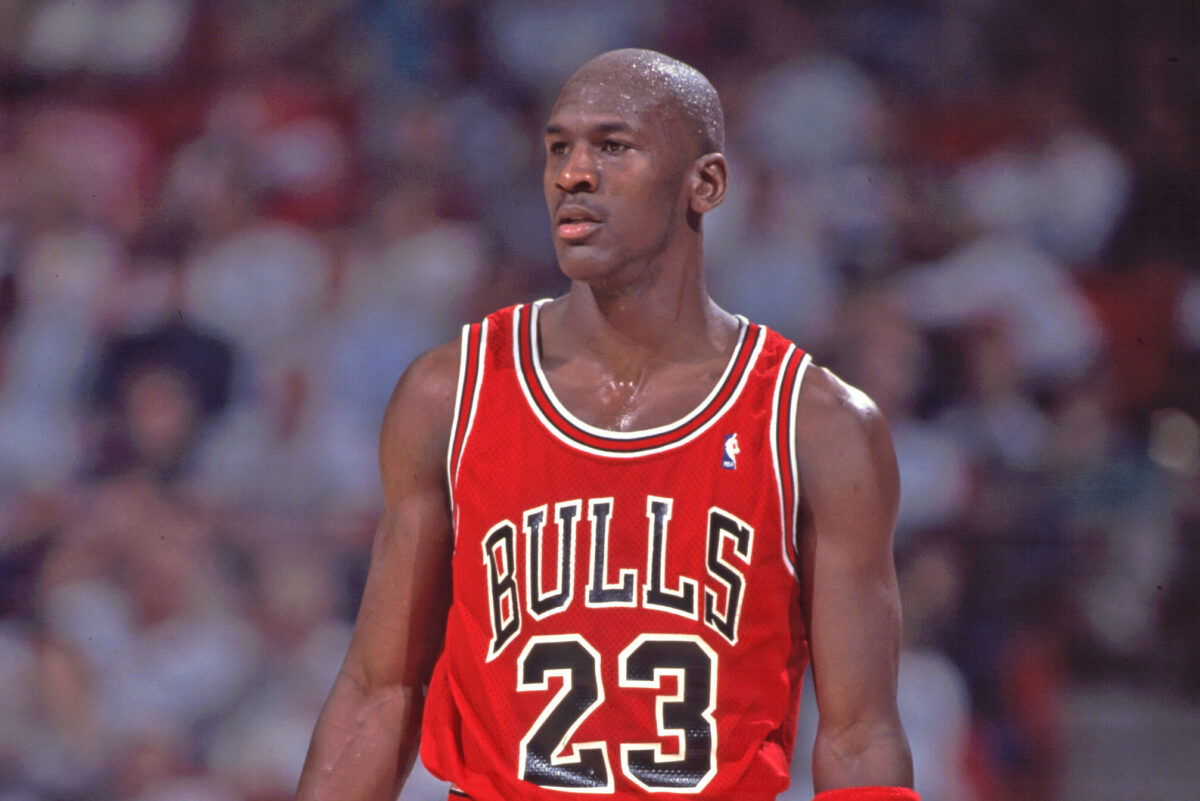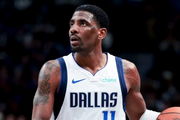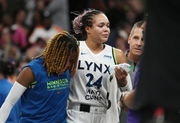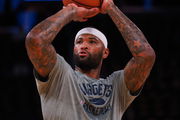
USA Today via Reuters
Unknown Date; Orlando, FL, USA; FILE PHOTO; Chicago Bulls guard (23) Michael Jordan during a game against the Orlando Magic at the Orlando Arena during the 1990-91 season. Mandatory Credit: Photo By USA TODAY Sports (c) Copyright 1991 USA TODAY Sports

USA Today via Reuters
Unknown Date; Orlando, FL, USA; FILE PHOTO; Chicago Bulls guard (23) Michael Jordan during a game against the Orlando Magic at the Orlando Arena during the 1990-91 season. Mandatory Credit: Photo By USA TODAY Sports (c) Copyright 1991 USA TODAY Sports
When Michael Jordan retired for good in 2003, Nike was naturally worried. Like, how do you keep selling your bestseller without the man playing? Most retired athletes don’t get new designs. Many have their signature shoes even discontinued to make way for newer stars. Michael Jordan was an outlier. The Jumpman became more than just a signature sneaker. A $7 billion brand of its own, that’s second only to the parent company—something Nike possibly didn’t predict was going to happen when Jordan finally left the court. Yet it’s something they had practiced and prepared for.
Watch What’s Trending Now!
Before we get sucked into a memory, let me give just a one-line context. In 2025, Nike is celebrating 40 years of Air Jordan and bringing back classics in more colorways. 32 years ago, this future was almost unimaginable. Three championships in, Michael Jordan was ready to call it an NBA career in 1993. MJ was shattered emotionally after losing his father, but Nike was in shambles after seeing its golden duck parting way from the court.
MJ himself described it in his 2005 book, Driven from Within. In an excerpt from that memoir, he said, “We had a big issue when I retired in 1993.” By ‘we,’ he meant Nike. Michael Jordan announced his retirement from basketball after losing his father. He switched to baseball, a sport his dad wanted him to play. But ‘minor league baseball player Michael Jordan’ didn’t have the selling appeal of ‘NBA superstar Michael Jordan’. “Nike didn’t think the Jordan product would sell if I wasn’t playing basketball,” Jordan explicitly wrote in his book. And it wasn’t misplaced fear.
ADVERTISEMENT
Jordan’s first retirement did cause a 22% drop in Nike’s revenue in 1994. Shockingly, the impact on sales was not the only problem. The Jumpman confessed that he and Nike became estranged for a while. “I kind of lost connection with the brand the year I played baseball,” Jordan admitted, and it had nothing to do with his semi-retirement. The Swoosh made a move that wasn’t approved by the face of the brand. “Because we came out with a shoe I didn’t approve.”
Reuters, in March 1994, reported, “Nike Inc., the athletic apparel maker, said yesterday that its earnings fell 29 percent in the latest quarter as it battled tough markets in the United States and abroad.” Hard to draw a parallel? Jordan announced his 1993 retirement in October of that very year. And to no surprise, in the very next two quarters, the situation didn’t look good for Nike, even though PR had polished words to make it look positive. Nike’s fall didn’t end here.
The press release by Nike further read as Reuters reported, “For the fiscal third quarter ended Feb. 28, Nike said net income was $62.2 million, or 85 cents a share, down from $89.5 million, or $1.16 a share, in the corresponding period a year earlier. Sales fell to $871.8 million from $972 million.” And it wasn’t hard for analysts to link it with Jordan’s departure from basketball.
ADVERTISEMENT

Imago
Feb 3, 1993; Sacramento, CA, USA: FILE PHOTO; Chicago Bulls guard Michael Jordan (23) dunks the ball against the Sacramento Kings at Arco Arena. Mandatory Credit: Imagn Images
Historians would recall that MJ wasn’t just the silent face of Nike. He kept them on their toes from the moment they pitched to him, even trying to go to Adidas before Nike made an offer he couldn’t refuse. Around the time he broke his leg, he was close to leaving Nike. So they sent sneaker design legend, Tinker Hatfield, to help him redesign a shoe that was true to His Airness. Hatfield kept the Jumpman-Swoosh partnership alive. But it wasn’t without issues.
ADVERTISEMENT
When Nike and Michael Jordan disagreed
In August 2025, the Jordan Brand is retro-releasing the Air Jordan 10 “Steel” in its original form – no new colorways, no added frills. This was the minimalist design that debuted as the Chicago Stadium, the Bulls’ home until 1994, was sent off. It was also the shoe Michael Jordan wore during a brief, surprising return to the basketball court for a charity game.
Despite wearing the shoes on a landmark occasion, Jordan was famously not fond of the Air Jordan 10s. Tinker Hatfield had designed them in private, meaning Jordan had no input whatsoever. With flights from Nike’s headquarters to Birmingham, where Jordan played Triple-A for a White Sox affiliate, being far from direct, the superstar didn’t even see the new AJ10s until they hit the market! “When I saw the final version of the 10, it already was in the marketplace,” Jordan recalled. “It wasn’t consistent with the way I thought the shoe should look,” clearly upset for not being kept in the loop.
ADVERTISEMENT
The design was everything His Airness didn’t prefer. Known for his meticulous attention to detail – a trait famously evident even in the precise 23-degree angle of his Cincoro tequila bottle – the stripped-down aesthetic of the AJ10 “Steel” simply didn’t align with his personal preference.
Top Stories
Kyrie Irving Breaks Silence After Injury Return Update Emerges

Prayers Pour In For Napheesa Collier After Unfortunate Health Announcement

Is Austin Reaves Dating YouTuber SteveWillDoIt’s Ex-Girlfriend? Fact Checking Viral Claim

Michael Jordan Could Have Repaired Scottie Pippen Relationship if He Wanted To: Former Teammate

Are Nuggets Signing DeMarcus Cousins? Fact Checking the Viral News

The shoe’s minimalist approach inadvertently carried another layer of symbolism: internally at Nike, some believed it signaled the winding down of the dominant Air Jordan line. This shoe never even made it to the overseas distributors. MJ claimed he’d never wear these 10s. As history goes, neither Nike nor Jordan was accurate on either front. MJ wore those shoes to the All-Star charity game hosted by Scottie Pippen. Then he’d unretire in two words – “I’m back” – the following year and win three more championships. And despite retiring again in 1998 and finally in 2003, the Swoosh and Jumpman didn’t divorce. Now, the Air Jordan boasts 40 flagship models.
Despite a slight alarm about Nike’s revenues until 2024, the brand still commands the biggest chunk of the global sneaker market, thanks largely to the Black Cat. As per reports, Jordan took a handsome $300+ million a year in 2024, mainly due to his partnership with Nike. But that’s not all. The sticking around has paid him in mind-boggling figures—much, much, much more than what you and I can even make in a lifetime (or two … maybe more).
ADVERTISEMENT
For starters, Jordan still receives royalties on every pair of Air Jordan shoes sold, with Nike reporting $7 billion in Jordan sales last year, a 6% increase from the prior year. Sportico‘s list, released on Tuesday, April 22, 2025, crowned him with career inflation-adjusted earnings of an astonishing $4.15 billion, placing him $1.36 billion ahead of the next highest-earning athlete, Tiger Woods. Clearly, that three-decade-old hiccup was a turning point for the brand. And the man.
ADVERTISEMENT
ADVERTISEMENT
ADVERTISEMENT

